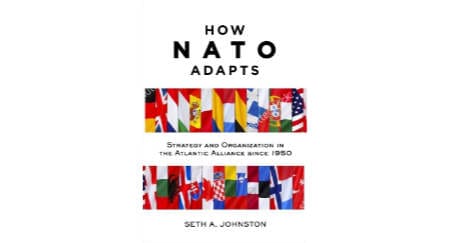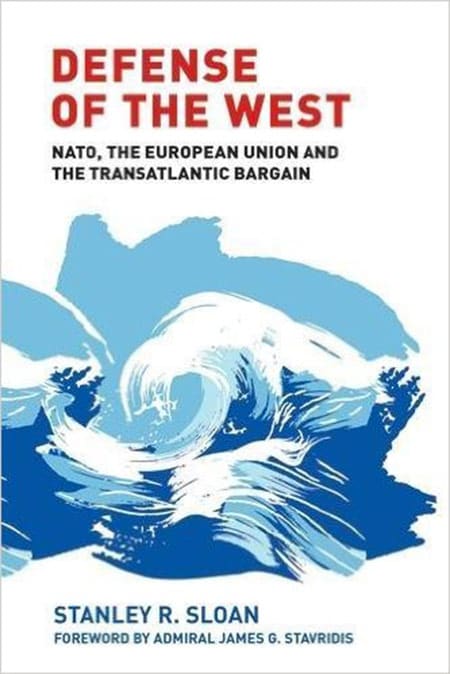In a “post-truth world” where NATO has become a convenient target for all kinds of fake news and conspiracy theories, it is reassuring to know that those who seek reliable information about the Atlantic Alliance will still be able to find it: Seth A. Johnston’s “How NATO Adapts” and Stanley R. Sloan’s “Defense of the West” are rock-solid accounts of the evolution of NATO, an evolution that now spans almost seven decades.
How NATO Adapts
Johnston tells the story by focusing on the “critical junctures” in NATO’s history, arguing that this framework will allow not only to look at how nations dealt with challenges, but also the organisation itself. The role of the latter, Johnston believes, has been underappreciated. One of several “critical junctures” selected for his account is the early 1950s, when the Korean War helped putting the “O” into NATO and the question of West Germany’s future in NATO became ever more pressing. Another is the early 1960s, when the Cuban missile crisis compelled the US (and, by extension, NATO) to search for a strategy with a reduced emphasis on early nuclear use. The third is the end of the Cold War (“NATO’s best known critical juncture”), when NATO’s very purpose was at stake.
By focusing on key events in NATO’s history, Johnston covers a lot of ground, while also delivering on his promise to examine the role of the organisation itself in driving NATO’s continuous adaptation. Examples include the institutional changes that had to be effected as a result of France’s withdrawal from the integrated military structure in 1966, and the subsequent re-location of NATO Headquarters and various commands from France to Belgium. Other examples of organisational adaptation mentioned by Johnston are the setting up of the Nuclear Planning Group, the adoption of flexible response, and not least the so-called “Harmel Report” of 1967 that helped rally the allies behind a set of common goals, helping to mitigate the massive crisis caused by French President De Gaulle’s political extravaganzas.
The drawbacks of this approach are equally obvious, however. The “critical junctures” chosen by Johnston are plausible, but focusing on some key events inevitably risks neglecting others. Occasionally, this leads to peculiar results: the violent dissolution of Yugoslavia is rightly identified as a stimulus for NATO’s transformation into a crisis manager, yet why this country collapsed is not explained at all. The struggle over the deployment of new nuclear weapons in Europe in the early 1980s, which was arguably one of NATO’s most severe crises, is barely touched upon.
These and several other omissions are in part the result of the “critical junctures” approach, yet they are also due to the author’s background: Johnston’s narrative is that of a US military practitioner. Consequently, changes in military strategy and structure are given extensive treatment, while some important political issues receive short shrift.
Due to the lack of sources, Johnston’s account of the role of key individuals, such as the various Secretaries General and Supreme Allied Commanders Europe (SACEURs), is somewhat uneven. Yet the information provided through these vignettes is sufficient to give the reader an idea of how bureaucracies can creatively adapt to changing circumstances. The nation states remain in charge, but if they disagree about which course to take, it falls to the organisation and certain key players within it to act as “honest brokers” and sketch a plausible way forward that facilitates consensus.
Some of Johnston’s views appear far-fetched, however. While it is easy to agree with him that Secretary General Manfred Wörner was “revolutionary” (p. 146), given his robust leadership style and his agenda-setting skills, his positive assessment of Wörner’s successor Willy Claes is peculiar, to say the least. From the start of his short one-year tenure, Claes was embroiled in an arms procurement scandal that simply did not allow him to make a mark on NATO’s transformation. Not having called a meeting of the North Atlantic Council in order to let airstrikes against Bosnian Serbs go unhindered may testify to Claes’ experience as a shrewd politician, but if this is the only act of “leadership” that Johnston could identify, he would have done better to just skip this part. Tellingly, Secretaries General Robertson, Rasmussen and Stoltenberg are only briefly mentioned; Solana and de Hoop Scheffer are not mentioned at all. For a study that seeks to describe NATO’s internal adaptation, this is too little.
In the penultimate chapter that seeks to cover Kosovo, the 9/11 terrorist attacks and Afghanistan in just a few pages, the author’s “critical junctures” approach becomes outright counterproductive. Seminal events like 9/11 are not really explained, as if the author assumed that the reader will know them well enough. And the Iraq war, which led to a crisis so deep that then US NATO Ambassador Nick Burns called it a “near-death experience” for NATO, is hardly mentioned. This is all the more peculiar as the author is quite aware of the fact that NATO’s taking over of the command of the International Security Assistance Force (ISAF) in Afghanistan in 2003 had a lot to do with patching up the strained transatlantic relationship post-Iraq.
“How NATO Adapts” is a good read, providing much solid information. However, its structure remains unconvincing. The “critical junctures” approach and the heavy emphasis on military issues results in critical omissions on the one hand and some rather daring judgements on the other. This limits its value as a textbook for students. For the NATO buff, however, the richness of information provided in this volume more than compensates for its structural flaws.
Defense of the West
Stanley R. Sloan’s “Defense of the West” does not boast an innovative analytical approach, which is perhaps why it is the better book of the two. “Defense of the West” is not only more comprehensive, it also provides a better balance between the political and military dimensions of NATO’s evolution. The book appears to be aimed at a student audience, as demonstrated by the “questions for discussion” at the end of each chapter, but its comprehensiveness makes it almost a NATO Handbook.
As in his previous books, Sloan builds on former US NATO Ambassador Harlan Cleveland’s famous notion of NATO as a “transatlantic bargain”. Sloan shows that as NATO evolved, its underlying bargain evolved as well. Whereas the original bargain was rather simple (post-war Europe would get its act together and the United States would help protecting the continent), the bargain became more and more complex. The emergence of the European Union as a new security actor, or the admission into NATO of many new member countries with distinct national interests meant that many “subordinate bargains” (Sloan) would have to be added.
Sloan also understands the dilemmas of security policy making, for example the painful splits experienced within NATO over inviting new members from Central and Eastern Europe without alienating Russia. Hence, he has this to say on Partnership for Peace (PfP), a cooperation framework developed to draw NATO’s Eastern neighbours closer to – yet not quite into – the Alliance: “The PfP concept was a policymaker’s dream. It signalled to those who aspired to membership that they had been heard. Yet it made no commitment concerning the future. Perhaps most crucially, it bought time. It avoided destabilizing relations with Russia … [and it] bridged differences between those in the US administration who favoured enlargement and those who were skeptical” (p. 113).
It is apt characterisations like these that put Sloan’s book above most others on NATO. Similar sound judgements can be found regarding NATO’s controversial Kosovo air campaign in 1999, or the Libya operation in 2011. In each case, Sloan lays out the pros and cons, without the moralising tone that is characteristic of so many other publications.
Regularly straddling both sides of the Atlantic as a sought-after lecturer, Sloan is keenly aware not only of the different security perceptions in North America and Europe, but also of the differences in the Allies’ political cultures and national peculiarities. He devotes an entire chapter to these differences (Chapter 5). His ability to cogently explain diverging views becomes particularly useful when he is describing major transatlantic disagreements, such as the 2003 Iraq War. Sloan explains how the entire crisis emerged, but he also offers sound reasons why it ultimately did not break the Alliance: the shared strategic interests and shared values were strong enough to keep the transatlantic bond from fracturing.
Sloan also devotes considerable space to the rise of the European Union, acknowledging it as a new reality that has to be factored into an enlightened transatlantic relationship. However, he seems to have dropped the unrealistic proposal he promoted in his previous books, namely a merger of the EU and NATO into a kind of new Atlantic Community. In today’s environment, such an idea appears more distant than ever.
The structure of “Defense of the West” is not always convincing, however. At times, the narration’s flow is interrupted by a checklist-type enumeration of points (e.g. pp. 193; 201-204), which makes these parts of the book appear as if they had been written in a haste. The penultimate chapter about “External threats and internal challenges”, which lists everything from cyberattacks to ineffective NATO-EU collaboration, comes across as a somewhat random collection of those issues that could not be fitted elsewhere into the text, even though it may be quite useful for students.
Finally, there is the issue of length: with over 370 pages (Johnston settles for about 250), Sloan’s book requires a patient reader. Those who muster that patience, however, will be rewarded: “Defense of the West” is a comprehensive and well-balanced account of NATO’s past and present.


